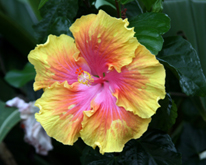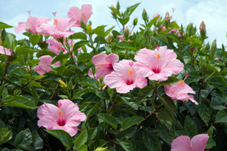Hibiscus Tree – Exotic Splash of Vibrant Color
If you’d like to add a splash of tropical color to your outdoor landscape, hibiscus flowers are the perfect choice.
A well known species of the hibiscus genus is the Hibiscus Rosa-sinensis, also referred to as Chinese Hibiscus, Tropical Hibiscus, and Chinese Rose. This plant is native to East Asia.
The evergreen hibiscus tree will grow up to twelve feet tall, with a spread of six to ten feet wide. The leaves are four to eight inches in length, and glossy, dark green in color.
Hibiscus flowers consist of five petals, with a range in diameter of four to eight inches.
The tropical blooms of the hibiscus shrub are short lived. Hibiscus flowers typically bloom for only one day, completing the cycle by closing up, and dropping off the shrub.
In ideal conditions, flower production is plentiful and year-round.
Hibiscus
Tree Care - Indoors
If you live in a cooler climate, you can still enjoy the exotic beauty
of hibiscus flowers.
hibiscus flowers. Plant containers are ideal for displaying hibiscus flowers in the garden or landscape during the summer.
Containers are portable, and can be easily moved indoors during the cold months for over wintering.
Tips for Over Wintering
Hibiscus Rosa Sinensis
Location -
The hibiscus plant requires a minimum of 5-6 hours of direct sunlight,
high humidity, and a temperature between 65° to 75° F for optimal
growth. Watering - Keep soil moist and mist plant daily with distilled water. Water hibiscus when the soil is dry to the touch. Note: Excessive yellow leaves could be a sign of over-watering. Over-watering can cause root damage.
Fertilizing – Fertilize monthly when your hibiscus is growing, bi-monthly during resting periods.
Re-potting – Hibiscus plants bloom best when the roots are slightly crowded in the container. If you decide to repot, go with a container two inches larger in diameter.
Outdoor Hibiscus Tree Care
Hibiscus trees grow in warm, humid climates, and add exotic appeal to
outdoor tropical landscapes and gardens.
to
outdoor tropical landscapes and gardens. A versatile landscape plant, hibiscus can be used as a hedge, provide privacy as a border, or be trimmed to resemble a small tree.
When planted in a container, the hibiscus can be easily moved indoors for over wintering.
Tips for Planting, Care,
and Maintenance
Hibiscus rosa-sinensis can be planted year round in hardiness zones
9-11. Hibiscus flowers thrive when planted in rich, organic soil with
good drainage. Be sure you choose a location that receives direct
sunlight to light shade.Steps for
Planting:
- Dig a hole 2-3 times the diameter of the root ball. Note:
The hole should be as deep as the root ball is tall.
- Carefully remove the root ball from the container.
- Place the root ball in the hole – the top of the root ball
should be visible at the soil surface.
- Fill in the hole with soil. Note: Water the plant during
the planting process to prevent air pockets.
- Form a basin around the plant to hold water until it drains down to the roots of the plant.
Care and
Maintenance:
- Prune hibiscus shrubs regularly to control growth and
encourage flower production.
- Place a 3-4 inch layer of mulch around the base of the
plant to conserve moisture and prevent weed infestation.
- Apply fertilizer twice a month during growing season.
- Water frequently during warmer temperatures. During colder months, water when the soil is dry.






